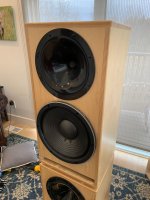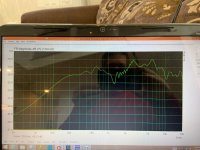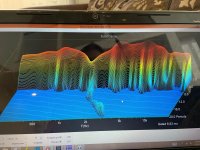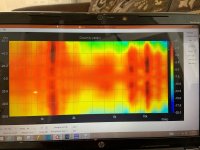All drivers were EQ'd to be the same - as close as reasonably possible. That said, the frequency response did end up being an audible effect, meaning that small variations in response are audible. The THD was not audible.
As we wrote up in AES many years ago, THD in a compression driver is not something that has an audible effect. Subjects could not tell the difference between 5% and 25% THD in a couple of compression drivers. It is simply not an important factor.
Not between 0,05 and 5 % either?
I mean, 5 vs 25 is like dead or very dead 🙂
//
Last edited:
Actually I don't know 🙂.
From what I have measured personally, I would highlight Meyer Sound MS-2010. They had distortions even less than 18Sound with beryllium membrane. 🙂.

This is because your setup is wrong or equipment not good enough to see the distortions. You need to measure distortions up to 20k. The distortions start at about 12k following the picture.
All drivers were EQ'd to be the same -
It is a pity that the paper does not contain the actual frequency responses of the drivers and the actual THD spectra. It would be interesting to compare the actual difference in the drivers performance. Trust, but verify, as the Russian proverb says.
This is because your setup is wrong or equipment not good enough to see the distortions. You need to measure distortions up to 20k. The distortions start at about 12k following the picture.
3rd harmonic of 20khz is 60khz harmonic. Why is it necessary to measure ? 🙄
The actual mic is CEL-192/2F (200V polarized, 3% of THD reaches at 146dB, but I have also RFT mk301, MK202, pair of CEL-186/2R...), preamp is rft-gefell mv201, the amp - MC2 650, analyzer - emu 0404 usb +REW. I have tested the measurement setup in the loopback mode by using a special "dummy mic" that is screwed instead of original capsule (ersatzkapazitat in your native language 🙂). The measurement setup is ok. 🙂
Last edited:
Seems that people still don't believe it after all these years 🙂
What can I say! Audio just doesn't want to move forward.
It is a pity that the paper does not contain the actual frequency responses of the drivers and the actual THD spectra. It would be interesting to compare the actual difference in the drivers performance. Trust, but verify, as the Russian proverb says.
Agreed, and it was discussed. The funder did not want to disclose what the drivers were.
3rd harmonic of 20khz is 60khz harmonic. Why is it necessary to measure ? 🙄
The actual mic is CEL-192/2F (200V polarized, 3% of THD reaches at 146dB, but I have also RFT mk301, MK202, pair of CEL-186/2R...), preamp is rft-gefell mv201, the amp - MC2 650, analyzer - emu 0404 usb +REW. I have tested the measurement setup in the loopback mode by using a special "dummy mic" that is screwed instead of original capsule (ersatzkapazitat in your native language 🙂). The measurement setup is ok. 🙂
You need to measure up to 40k in REW to see the 2nd harmonic distortion from 10k to 20k. Your mic is not good enough to measure this? please let us see this range. And you should use the RTA to measure distortions which is much more accurate. Furthermore, you need sufficient ppo (48 or even more) between 10k and 20k. Otherwise you measurement hides more that it shows.
Last edited:
You need to measure up to 40k in REW to see the 2nd harmonic distortion from 10k to 20k. Your mic is not good enough to measure this? please let us see this range. And you should use the RTA to measure distortions which is much more accurate. Furthermore, you need sufficient ppo (48 or even more) between 10k and 20k. Otherwise you measurement hides more that it shows.
For now I can upload the same graph measured for 18sound compression driver, that was measured at the same conditions on the same.
The mic is almost flat up to 20kHz (nonlinearity of freq. Resp. reached up to +1dB relative to mk301). I never measure above 20khz because I don't understand why I need it at all. Actually, I can try to measure up to 40kHz, but first need to find appropriate loudspeaker 🙂. Is there on Diyaudio appropriate topic for acoustic measurements discussion ?

Yeah but why? I guarantee you won't hear practically any amount of 10 kHz H2 (which results in 20 kHz), let alone anything above that.You need to measure up to 40k in REW to see the 2nd harmonic distortion from 10k to 20k
If that is calibrated spl level - better wear ear protection!
//
Yes, the level is calibrated it was very loud. 🙂
An axisymmetric "OS" waveguide, ⌀574 x 210 mm -
Looks like a feasible option, mabat.
OS done/gone wrong?
These 2 ways with a OS waveguide (DDS, I believe) and TAD TD-2001 were brought and measured by Joseph Crowe.
Attachments
Last edited:
For now I can upload the same graph measured for 18sound compression driver, that was measured at the same conditions on the same.
The mic is almost flat up to 20kHz (nonlinearity of freq. Resp. reached up to +1dB relative to mk301). I never measure above 20khz because I don't understand why I need it at all. Actually, I can try to measure up to 40kHz, but first need to find appropriate loudspeaker 🙂. Is there on Diyaudio appropriate topic for acoustic measurements discussion ?

NSD 1480 N?
Which horn?
NSD 1480 N?
Which horn?
 you guessed right. The horn is 18sound 1496c. (MS-2010 was measured with the same horn) 🙂
you guessed right. The horn is 18sound 1496c. (MS-2010 was measured with the same horn) 🙂Agreed, and it was discussed. The funder did not want to disclose what the drivers were.
Yes, effect of audibility of THD was widely discussed, and some conclusions in some papers are not entirely consistent with your findings. E.g. here is
a quote from introduction and conclusion of the paper of dr. A.Voishvillo
In the presence of musical or speech signals
the nonlinearity associated with the breakup modes
adversely affects subjective sound quality and manifests
itself in the form of harshness of the reproduced sound
that may be very irritating to the listener.
A new approach to the design of compression drivers
was proposed. The approach is radically different from
the traditional way of designing compression drivers
that are based upon a metallic dome diaphragm and
surround. Instead of using a single large and “heavy”
metal dome diaphragm, two annular flexural
diaphragms made out of a light but strong polymer film
are used. Each diaphragm is driven by its own voice
coil, which is in turn energized by its own dedicated
magnet assembly and whose output is presented through
its own phasing plug. This approach makes it possible to
design highly efficient and compact transducers that
have increased power handling capacity, smoother
frequency response, and significantly lower levels of
nonlinear distortion compared to traditional
compression drivers. These lower distortion levels are
both measurable and audible.
This advantage in objective parameters compared to the
traditional designs propagates to the improved sound
quality. This statement has been substantiated by
numerous subjective listening tests conducted at JBL
Professional in particular during development of JBL’s
new full-size, multiway line array element. The
configuration of the new dual driver is scalable for
different formats. The newly-developed dual drivers
vary from 1.5” voice coil diameter to 3” voice coil
diameter, having respective exits of 1” and 1.5” in
diameter. In addition, extra flexibility of the new dual
driver for loudspeaker system designers is provided by
the possibility of connecting the voice coils either in
parallel or in series. This new approach to building
compression drivers is a subject of unique and
proprietary invention and the patent is pending. The
new design opens a pathway leading to the design of
professional loudspeaker systems with significantly
improved performance and sound quality, with a
hallmark achievement being the reduction of nonlinear
effects and significantly reduced distortion.
My subjective observations are roughly the same as Dr. Voishvillo's remarks, although I cannot fully rely on them since they were not well controlled (I have not performed ABX testing, not equalized linear distortion, etc.). Therefore, I was interested in the details of your experiment.
Last edited:
Yes, effect of audibility of THD was widely discussed, and some conclusions in some papers are not entirely consistent with your findings. E.g. here is
a quote from introduction and conclusion of the paper of dr. A.Voishvillo
pls allow delete....
Last edited:
you guessed right. The horn is 18sound 1496c. (MS-2010 was measured with the same horn) 🙂
Don't want to brag, but it wasn't a guess 😉
How do you like the driver(s)?
Last edited:
Don't want to brag, but this wasn't a guess 😉
How do you like the driver?
Actually, I was too impressed with MS-2010, so I don’t remember how good it was. It may seem unexpected, but I was also impressed by Beyma's 755 driver (bearing in mind its price) 🙂.
- Home
- Loudspeakers
- Multi-Way
- Acoustic Horn Design – The Easy Way (Ath4)



